2. An actual stage of V-twin development
2.1 Background
First MOTO GUZZI V-twin motorcycle is V7.
At the beginning of 1960's, there's next two reason that faced MOTO
GUZZI to develop such a bike.
First : Italian administration needed it. On that period, increasing
cars has changed Italian road traffic, and new high performance police
motorbike has begun to be wished for replacement of ancient models,
like Falcone.
Second : needs of motorcycle market. That opportunity has broke first
at north America. People has begun to want more big bikes, that must be
cool with high performance and nice style. Many north American dealers
has begun to push motorcycle makers to develop such a mode of bike.
I can't determine which reason was dominant, but the words of Carcano,
who is a responsibility of development of V7, mentions that the former was
the predecessor, and the latter followed.
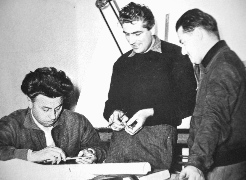
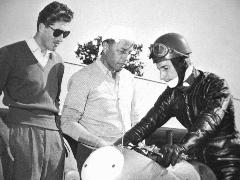
Left picture is a view of the office of that time. From left,
Carcano, Cantoni (disciple), Todero (right hand man).
Right picture is a view at a circuit, 1952 Monza. From left, haughtily
pupil, master of craftsmanship, rider on the bike is Lorenzetti.
(both are from reference No. 1)
2.2 The eve
At the beginning of 1960's, MOTO GUZZI had some meeting for
marketing with biggest dealers, especially of north America. They
argued intensely, using some drawings or illustrations, and they
seemed to achieve some model concepts. And those prospects matched to the
requests of Italian administrations too, so MOTO GUZZI could challenge to
develop all these at once.
The witness, Mr. Carcano said that the request of Italian administrations
made V7 project start first, and then civilian version chased it with
some evolution.
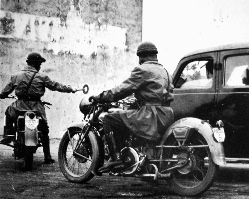 A view of police activity of those days. (ref. No. 1)
A view of police activity of those days. (ref. No. 1)
You may say that's differs from established dogma (or rumor) of the
birth of V7, like below.
- Its beginning was some drawings that Carcano made.
- At first, some drawings was proposed to the Italian administrations.
You may Imagine one person, who intended to research the origin of MOTO GUZZI
V-twin. After some jobs, at far deep of the archives of MOTO GUZZI, he might reach a
drawing, which was made for that meeting. His data is only that. He would
image how could be that, and he could say the rumor was truth.
It's just a my image, but also the rumor is a image. Did you see that
drawing of rumor actually ? There's no proof.
But Carcano still lives, and talks. That is far preferable. I'll
believe him.
Let's go back to the real development stage of GUZZI V7.
MOTO GUZZI had a long history of contribution for Italian administrations
from post war period, and it had already gotten a good deal of
evaluations and trusts. And that helped MOTO GUZZI to get a new order
again.
I guess admin. made serious evaluation for technical level, production mass
capacity, support ability, etc. And over these considerations, they let
MOTO GUZZI a new project : next generation police bike.
And MOTO GUZZI determined to meet this chance.
Italian admin. showed some specifications. That is :
- High performance that could surpass urban traffic.
- Fine structure that makes maintenance easy.
- 10,000km distance range without heavy maintenance.
2.3 Birth
The captain of development was Carcano. He was a leader of MOTO GUZZI
GP racing team, made V8 racer, and later led the development
team of FIAT engine. He started the examination of V7 at the
mid of 1963.
Remarks of specific concept are like below.
- Twice power of Falcone would be needed, that leads displacement of 700 cc.
- For the weight and power of that class, chain drive wouldn't
achieve sufficient maintenance range. So a shaft drive system should
be must.
- Air cooling engine would contribute to the simple mechanism and light weight.
- Engine type should be a transverse V-twin with OHV system, because:
- Each cylinder could be cooled independently. (It's cool, really.)
- OHV could make it's mechanism simple, and engine head maintenance easy.
- It could be mounted to the body at low height. And when
it turn over, it would
suffer less damage compared to the flat twin.
- No balancer needed, that's contributes to the simplicity of
the engine.
- Shaft drive system could be fitted easily.
References say that MOTO GUZZI made detail analysis about the engine
component against British
parallel twin, American longitudinal V twin, German flat twin, etc.
That new motorcycle was named as V7, which came from its engine
displacement : 700 cc, and it's development has started at this time.
The roots of its V twin engine can be said the one of previous testing
study for FIAT. They have a lot of similarities for its basic
structure. So its son could inherit directly its father's virtue,
including reliability, fitting for mass production, etc. But they
are perfectly different engines, displacement differs, connection to
the gear box differs,... they made all the parts renewed. MOTO GUZZI
did not reuse the previous engine. They made totally new engine focused
on motorcycle, with basic technical knowledge they had already
established at that time.
And then, a "real durable 100,000km bike" had begun to be formed.
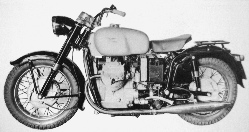 V7 prototype (ref. No. 3)
V7 prototype (ref. No. 3)
At the beginning stage of development of V7, some prototype has
delivered to the administrations and evaluated there. Italian
police society is divided according to its competent authorities, like
army police, financial guardian, urban police, etc. Each of them might
show its own specific request, and that might complicate MOTO GUZZI.
But they've checked many specifications at one time in parallel, and
that might drive its brush-up.
And here, I would touch another important topic of this time.
One of the company founder, Carlo Guzzi was ill in bed at this time of
V7 development. He had already retired his carrier, but sometimes he
seemed to assist troubled staffs with significant suggestions. Some
references says that there was also his back up for V7 development,
and for V7 project too.
First V7 prototype delivered at the beginning of 1964, and he died
November of the same year.
I don't know his tender eyes could see running V7. But I'd say, at that
time, MOTO GUZZI shifted its organization from first generation of
Carlo Guzzi to the second of Carcano. The development of V7 confirmed
that, and MOTO GUZZI established new formation.
That could also be seen apparently on the change of motorcycle architecture
from horizontal single cylinder to transverse V twin.
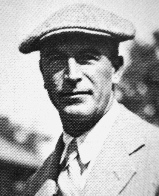
Tender calm eyes always saw the truth
and the essence. (ref. No. 1)
2.4 Contest
V7's next stage was a "contest".
It isn't clear that the Italian admin. intended fair contest, which means
comparison of candidates on even punctuality and condition, then judgment
of the excellence. But for motorbike makers, the need of police is stable and
big. And running police bikes scatter the image of performance, durability,
and advantage. Many makers would approach to it successively.
Some reference says, in 1966, police bike contest was held. The entries
were, MOTO GUZZI, Laverda, Gilera, and Benelli.
Its main selection was 100,000km continuous running test. But at
31,000km, only MOTO GUZZI remained, the other runner has already
dropped off. That could be assumed that all the others of MOTO GUZZI
broke its crank shaft, because at that time, it meant directly the life
time of bike itself. Left alone MOTO GUZZI continued running
test, and after 86,000km, it was disassembled and examined in detail.
Its mechanism kept fine condition, outside trim was a bit tired though.
Running test finished. GUZZI won.
Also the mechanical maintenance capability was checked. GUZZI won
again. Estimate pointed out easy accessibility for cylinder head, which
sticks out besides the body, and simple OHV mechanism could be adjusted
easily.
Carcano's steady engineering has born fruit here. V7 won the next
police bike.
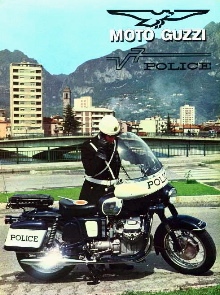
At a glance, it looks much stronger than the previous FALCONE.
(The picture is from MOTO GUZZI owners club of Japan.)
Now, let's look how the other entrants were.
Benelli and Gilera. They don't seem to release new model at this time.
Contest entrants can be imaged like a one of trial production. Well,
about these makers, I can image some beautiful ancient racers soon, but
how was the production models ?
Laverda. In 1966, at London motorcycle show they released a 650 cc twin
model , which was the ancestor of SFC, later famous sports star model.
Contest entrants should be one like this 650.
Ducati. Some reference says they missed punctual, but in 1967, they
delivered 700 cc parallel twin model to the local carabinieri (army
police). Ducati was managed partly by Italian nation at this time, so
they had enough connections to the local organizations. There might be
no need to enter that contest. But that twin model couldn't be
evaluated well, because of big vibration, etc., and disappeared soon.
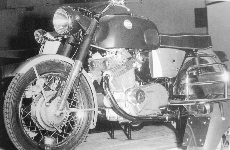
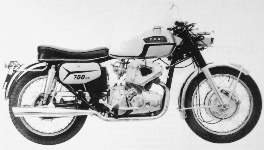
LAVERDA 650 (Nov. 1966 London, reference No. 11)
DUCATI 700 twin (ref. No. 10)
You can see that all the entrants beside MOTO GUZZI were parallel twin
model of 500 cc or a bit more, with chain drive. V7 was quite unique.
And it shows that it was only MOTO GUZZI that aimed a real 100,000km
bike with few maintenance.
But for the other makers, it was not a dissipation to develop such
a bike. Because, after this period, surviving bike makers
were limited to the ones that succeeded to develop appealing big bike
and got some share in the market.
2.5 Evaluation for V7
V7 civilian production models was also prepared, and
appeared in the Milan show at the end of 1965.
MOTO GUZZI was a maker that was faithful and conservative for
production method, so they had already finished diagnosis and foresight
for mass production. They displayed reliability, productivity,
performance, etc., not only its body style.
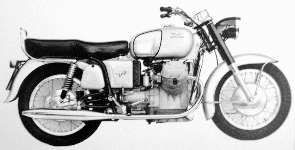 Civilian V7 prototype. (ref. No. 3)
Civilian V7 prototype. (ref. No. 3)
In this period, MOTO GUZZI have already established a fame as a veteran
maker. And the market welcomed the new challenge, as a result of deep
considerations over a long experience.
Under the spot light on the stage of Milan show, V7 was shining, with
the proud of a newest gold eagle emblem. That could be said as a
expression of a new identity of MOTO GUZZI.
Now, here in Japan, how was the evaluate of the market ?
Impressions of the magazines in those days can be summarized like " It
has a unique structure, but it runs very fine. Performance and
durability has a good balance. And sure, its the MOTO GUZZI, that
should be tested much, like their other GUZZI."
I'd say that's very practical review than the recent snobbish ones.
2.6 The jobs of Carcano
"Your V-twin still holds MOTO GUZZI, and many enthusiasts evaluate it still now.
It's amazing, isn't it ?"
"... Is it ?"
Giulio Cesare Carcano. He is really a cool man.
"I did do nothing new for my V-twin. There were many examples of 90 degree
V-twin engine before mine. And I knew how was the shaft drive system already.
Its moment affects badly for racers, but good and practical for a production
model like tourer. Sure, it's amazing it's still selling besides that
sophisticated Japanese bikes. Well, when I made it, it had a good sales
for world wide police market, not only Italy. Sure, It's natural, I made
it to sell for them. It hit the time. It was a lucky bike."
His job was practical and direct. It's the contrary of stereo
type of engineer, like an expert of his home architecture with hard
effort for long time, for example.
He preferred new architecture, good example is the V8 racer after
horizontal single. It looks unique, but he considered deeply many factors, like
technical level and possibility, purpose of the bike, etc. The
solutions are unique, special, and convincing. That's really
professional jobs. Successive individual solutions may conflict
audience, "how was his mind". All that may be the same of an ancient
Roman hero with same name, Julius Caesar.
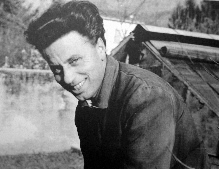
Carcano in holiday (1954, ref. No. 6)
Let's see the structure of V7 again.
Upper end of swing arm pivot section is connected with bold pipe to the
steering head, that is the main bone which holds the bike. Besides,
mild cradle frame holds the engine. MOTO GUZZI racers of the days have
same structure, but their beautifully shape is a contrary of the V7,
very strong and bold.
Engine is mounted low, so its gravity center is low, too. That's the
same idea of ancient MOTO GUZZI philosophy as you can see in horizontal
single bikes. It runs smartly, easy and swinging.
Carcano left MOTO GUZZI at the period of "taking over". But his
engineer carrier continued in the field of ship, which he preferred
than motorbikes, he succeeded as the designer of speed boat.
And now he still lives at the lakeside of Como, and enjoying Americas
Cup, F1 car races, Moto GP, etc.
"How do you say if you work in MOTO GUZZI now again ?"
"Well, nowadays, big bike market seems to be divided in
two, hot super bike, and convenient scooters. But easy Moto GP image is
not practical for average road riders, they wouldn't do with 100ps for
a small tire contacting area as a post card. Ah, horizontal single may
be interesting, but there would be no market. Well, If you allows me to
image in the same way of V7, how about a diesel common rail 3 cylinders
bike for police market ? All the fuel you need is just one tank for a
month !"
Now he's beyond the cool, and maybe a joking Italian grandpa.
But he's now 93 years old at 2004. and still keeps clear remembrance
and severe opinion.
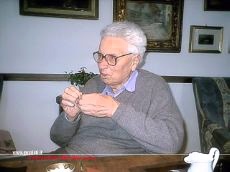
Hard work and long life, sure, you're super grandpa. (ref. No. 2)
>> annotation :
Colored letters above are easy translation of the site below.
http://www.guzzisti.it/maestri/carcano/carcano_body.htm
(reference No. 2)
Some photos are also referenced from this site.
>> postscript :
Giulio Cesare Carcano has died at Sep. 2005, 94 years old.
I'd like to say good bye and thanks much for our super grandpa, and his
marvelous jobs.
-- next : V7 and V7 sport
-- to the page top
-- to the site top
Copyright(C) 2005-2009 Public-road Motorcycle Laboratory All rights reserved.


 A view of police activity of those days. (ref. No. 1)
A view of police activity of those days. (ref. No. 1) V7 prototype (ref. No. 3)
V7 prototype (ref. No. 3)



 Civilian V7 prototype. (ref. No. 3)
Civilian V7 prototype. (ref. No. 3)
